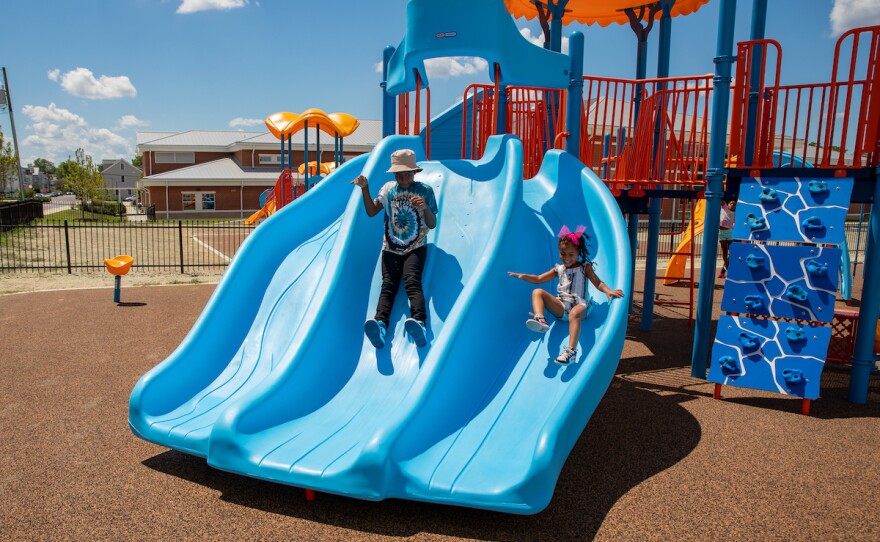With the flash of a few oversized scissors and a round of applause, a new playground in Richmond’s Church Hill neighborhood officially opened Thursday.
At the playground located outside Henry L. Marsh III Elementary School, students and members of the public can now find a vast jungle of colorful monkey bars, plentiful slides and several nonmechanized merry-go-rounds.
Skyler Hayden, a third grader at the school, was among the first children to enjoy the new facilities: He and his brother raced each other around the merry-go-round as soon as the ceremonial ribbon was cut.
He said the new play structures are a huge improvement.
“I’ve never seen a playground like this,” Hayden said. “This one is better compared to other playgrounds.”
The construction of this site is part of the city’s project to build three new schools, including Henry L. Marsh III Elementary, which was previously known as George Mason Elementary. The project was funded by a 1.5% increase to the meals tax that was approved by City Council in 2018. According to Mayor Levar Stoney’s press secretary Jim Nolan, the playground is the last project those funds will be used for, as all three schools have been constructed.
The city spent more than $143 million to construct the three new schools, including Marsh elementary, Cardinal Elementary School, formally known as E.S.H. Greene, and the former Elkhardt-Thompson Middle, which is now River City Middle School.
According to Cheryl Burke, who represents Marsh on the Richmond School Board, these three schools were chosen because their facilities were among the most outdated in the district. Before it was replaced, George Mason had not been updated since 1992, according to Style Weekly, and most of the structure was built about 70 years ago. Burke said when she toured the former George Mason campus at the beginning of her first term in 2017, the need for new facilities was already obvious.
“My heart was broken. So, when it came time to [choose] what schools we're going to build, I pushed, I prayed, and here we are,” Burke said.
Stoney assisted in the ribbon cutting ceremony and marked the occasion by taking a trip down one of the playground’s newly constructed slides. He said the playground’s completion is a milestone for the city.
“Public schools are community assets, and the children in this neighborhood deserve a safe, fun playground,” Stoney said.
The area’s been gentrified since the 1990s, creating a socioeconomic division in the neighborhood. Several public parks concentrated in the southern portion of Church Hill, less than a mile from the school. Access to green space is tied to the history of segregation and Jim Crow in Virginia, according to Kathy Hudson, CEO of Kaboom, a nonprofit that helps communities build playgrounds and conducts research about the significance of play in children’s development.
“Segregation was fundamentally in our public spaces. So, when this country was segregated, our public spaces were segregated in terms of where Black people could shop, where they could eat, where they could drink water,” Hudson said. “Decades ago, the country was built around who had access to what facilities and who did not. And there were intentional investments along the way in … white communities, versus intentional disinvestment in communities of color.”
According to a 2008 study by the National Library of Medicine, between 70 and 80% of children from minority racial groups in the U.S. do not have access to recreational facilities like parks or playgrounds. Meanwhile, 38% of white children also cannot easily access these resources.
“The physical activity and the social stimulation that play can provide, it is an essential part of who we become,” Hudson said.
Though several hundred children younger than 10 live in the northern section of Church Hill, data analyzed by VPM News shows that the highest concentrations of children in the city center live around Richmond’s public housing neighborhoods.
Mayor Stoney said he hopes to improve conditions in those lower-income neighborhoods in the near future.
“We got to invest in other places in Southside, like we're doing with George Wythe High School, and other schools we’ve seen over the last decade come to life because of investment from the city administration,” Stoney said.



